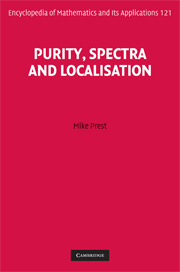Book contents
- Frontmatter
- Contents
- Preface
- Introduction
- Part I Modules
- Part II Functors
- 10 Finitely presented functors
- 11 Serre subcategories and localisation
- 12 The Ziegler spectrum and injective functors
- 13 Dimensions
- 14 The Zariski spectrum and the sheaf of definable scalars
- 15 Artin algebras
- 16 Finitely accessible and presentable additive categories
- 17 Spectra of triangulated categories
- Appendix B Languages for definable categories
- Appendix C A model theory/functor category dictionary
- Part III Definable categories
- Appendix D Model theory of modules: an update
- Appendix E Some definitions
- Main examples
- Bibliography
- Index
12 - The Ziegler spectrum and injective functors
from Part II - Functors
Published online by Cambridge University Press: 05 March 2013
- Frontmatter
- Contents
- Preface
- Introduction
- Part I Modules
- Part II Functors
- 10 Finitely presented functors
- 11 Serre subcategories and localisation
- 12 The Ziegler spectrum and injective functors
- 13 Dimensions
- 14 The Zariski spectrum and the sheaf of definable scalars
- 15 Artin algebras
- 16 Finitely accessible and presentable additive categories
- 17 Spectra of triangulated categories
- Appendix B Languages for definable categories
- Appendix C A model theory/functor category dictionary
- Part III Definable categories
- Appendix D Model theory of modules: an update
- Appendix E Some definitions
- Main examples
- Bibliography
- Index
Summary
This could be seen as the technical heart of the book: the category of modules is embedded in a functor category, pure-exact sequences become simply exact sequences, pp conditions and modules now become the same kind of object. Restriction to closed subsets/definable subcategories is exactly finite-type localisation. Rings of definable scalars are shown to be endomorphism rings of localised functors.
Making modules functors
The category of modules is embedded into the functor category and the main properties of this embedding established in Section 12.1.1. The injective objects of the subcategory of finitely presented functors are identified in Section 12.1.2. The embedding allows the Ziegler spectrum to be realised as a topology on the set of indecomposable injective functors (Section 12.1.3).
The tensor embedding
Tensor product over rings with many objects is defined and illustrated. Then the embedding of the category of right modules into the category of functors on finitely presented left modules via tensor product is defined. This embedding is full, commutes with direct limits and products, and is left adjoint to evaluation at R (12.1.3). It takes pure-exact sequences to (pure-)exact sequences (12.1.3, 12.1.6).
Information
- Type
- Chapter
- Information
- Purity, Spectra and Localisation , pp. 492 - 532Publisher: Cambridge University PressPrint publication year: 2009
